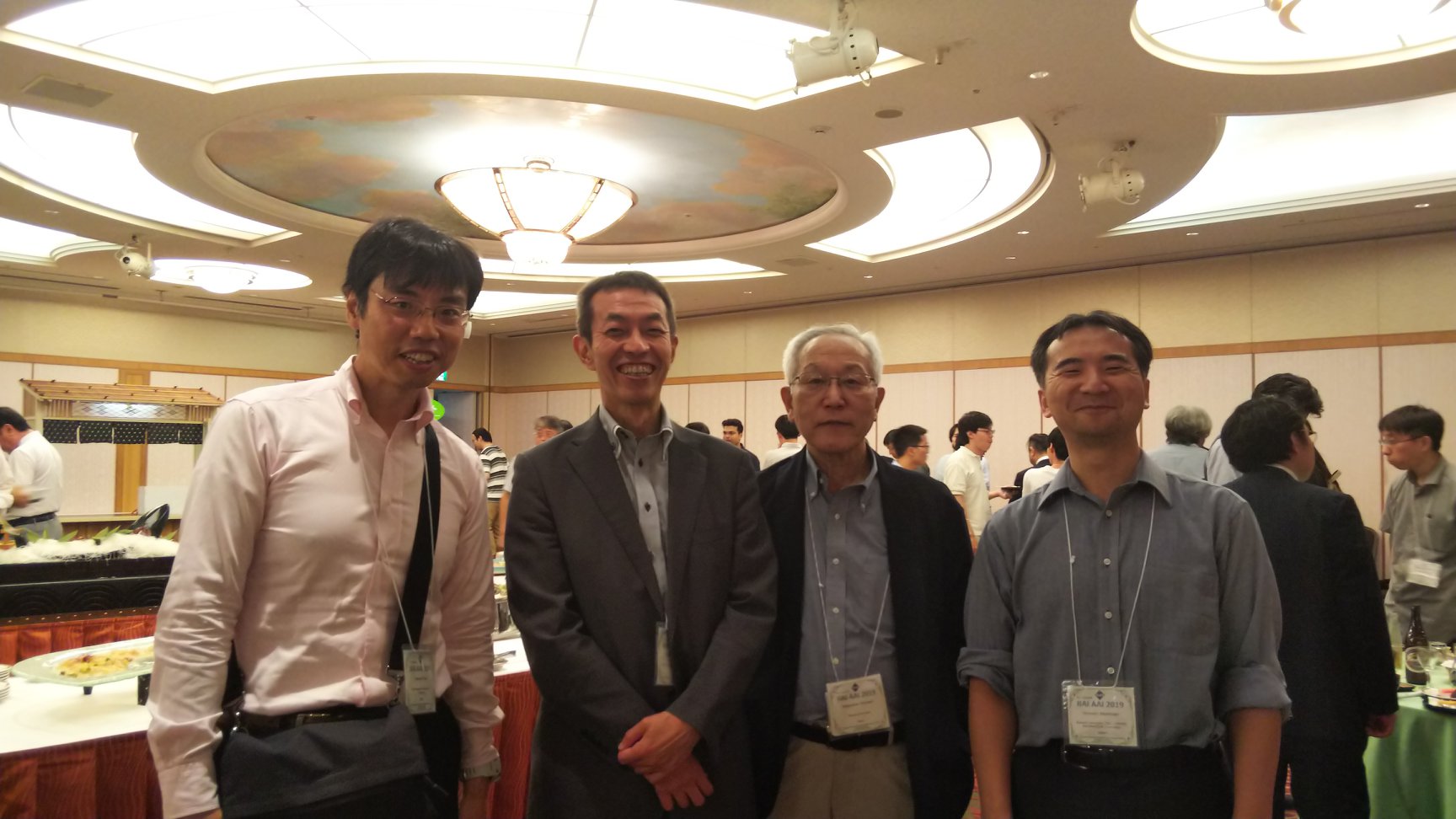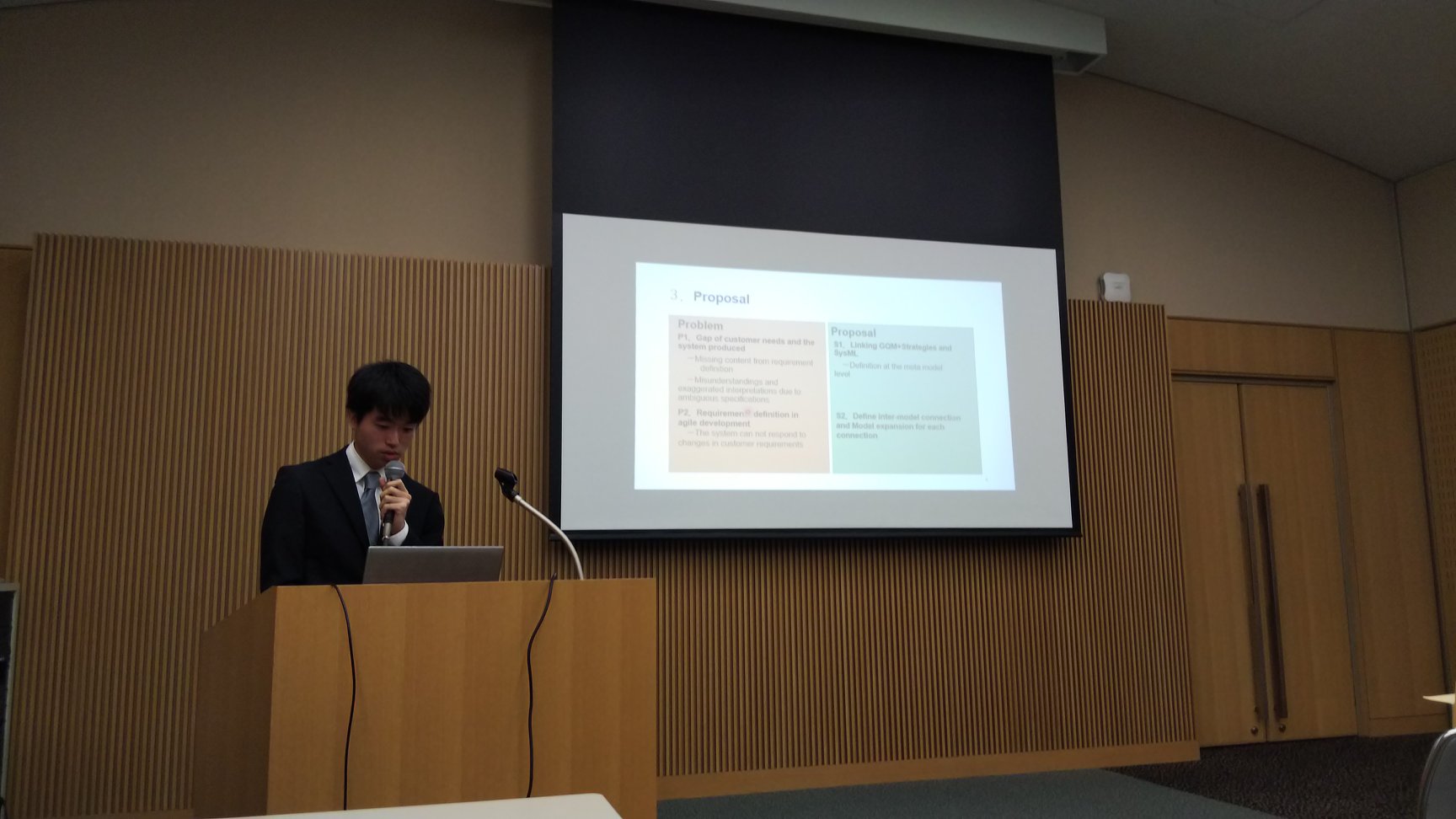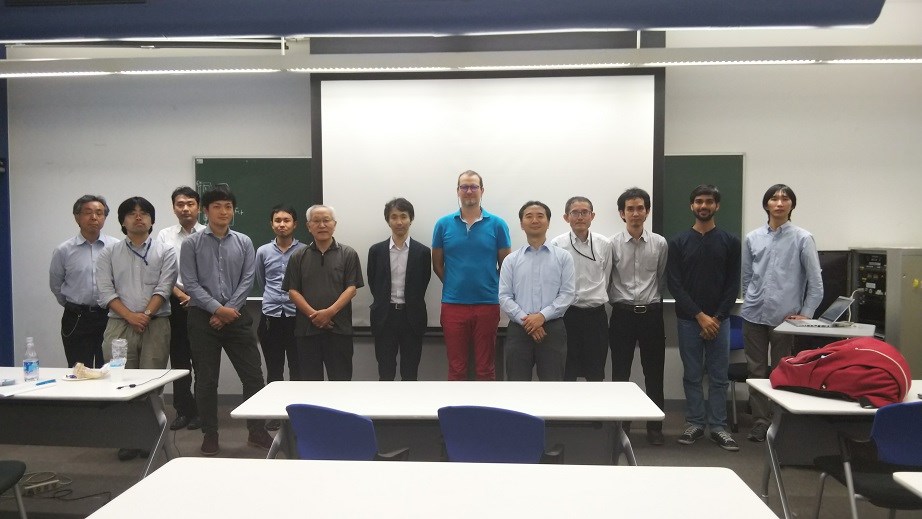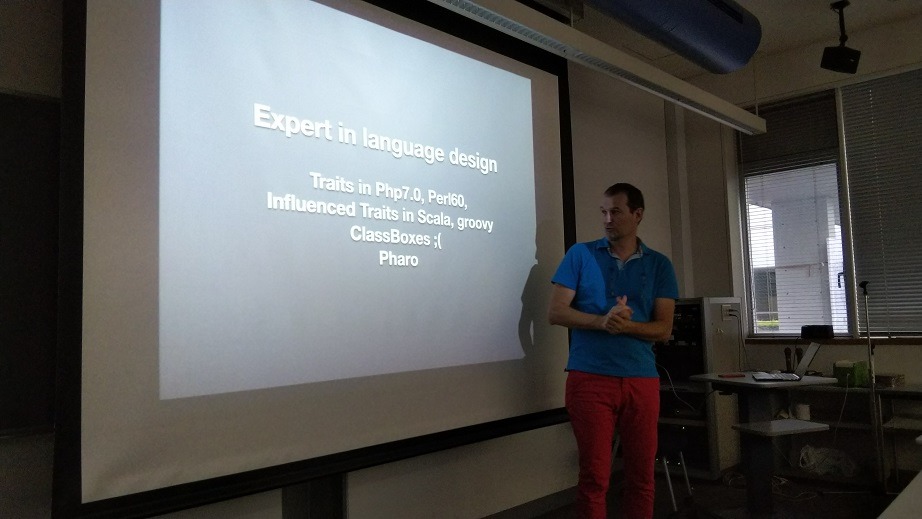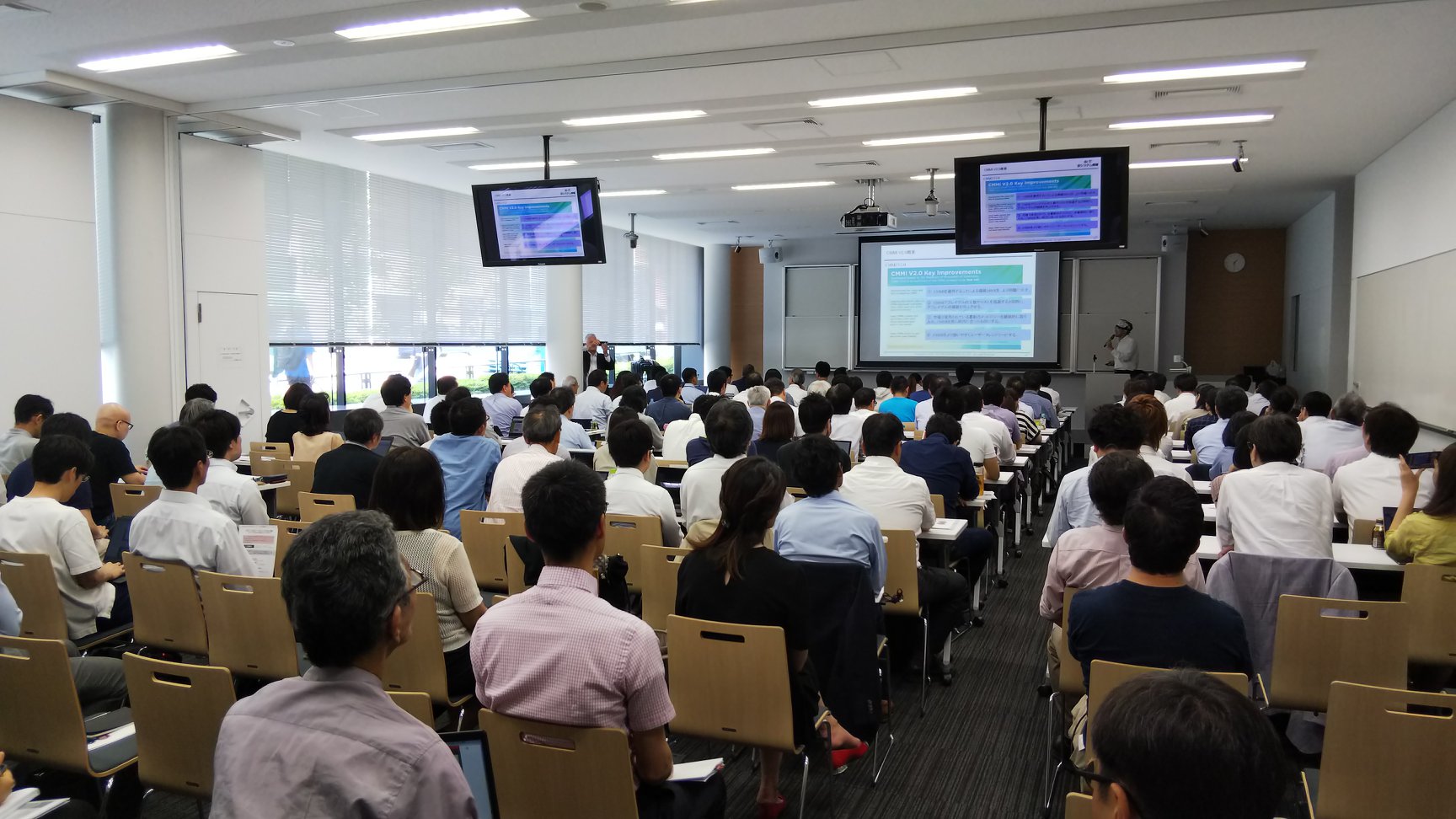8/29 ソフトウェアエンジニアリングシンポジウム SES2019 にてワークショップ「ビジネスと社会のためのソフトウェア工学に向けて」小林さん・谷口さんとご一緒に設置 SE4BS Prj成果をご紹介しつつDX時代のソフトウェア工学を考える参加型の機会ですのでぜひご参加ください。
2ページ以内のポジションペーパー投稿の場合は8/2締め切り、投稿なしの場合は8/9申し込み締め切りです。
作成者別アーカイブ: washizaki_lab.
Joined SNPD2019 and AAI2019/EAIS2019 in Toyama to present our achievements on Model checking, and organise special session on GQM+Strategies with Shintani-san. Shuji presented paper on linking GQM+Strategies and SysML.
SmartSE スマートエスイー座学部分一部収録の形で「セキュリティ・プライバシ・法令」、「推論・知識処理・自然言語処理」のオンライン講座が追加無料開講
SmartSE スマートエスイー座学部分一部収録の形で「セキュリティ・プライバシ・法令」、「推論・知識処理・自然言語処理」のオンライン講座が追加無料開講。ぜひご利用ください。
Stephane Ducasse from INRIA Lille, France, visited Waseda University on July 2nd 2019 to give his keynote titled 10 Years of Research around Software Evolution at SmartSE Seminar.
プログラミング教育推進校 大田区立 北糀谷小学校 開催の研究実践報告会にて “若年層におけるプログラミング学習の事例と学びの見える化” と題し、鷲崎教授・齋藤講師が、同じルーブリックでワークショップ、中期制作系、長期ロボットプログラミング授業での学習結果を比較講演
鷲崎弘宜, “若年層におけるプログラミング学習の事例と学びの見える化 – 地域ICTクラブ事業およびルーブリック・評価規準開発成果より -“, 東京都教育委員会 プログラミング教育推進校 研究実践報告会 大田区立 北糀谷小学校, 2019年6月28日
Inappropriate Usage Examples in Web API Documentations, accepted for ICSME 2019 short papers track
Masaki Hosono, Hironori Washizaki, Kiyoshi Honda, Hiromasa Nagumo, Hisanobu Sonoda, Yoshiaki Fukazawa, Kazuki Munakata, Takao Nakagawa, Yusuke Nemoto, Susumu Tokumoto and Supasit Monpratarnchai, “Inappropriate Usage Examples in Web API Documentations,” 35th IEEE International Conference on Software Maintenance and Evolution (ICSME’19), short papers track, Cleveland, Ohio, USA, September 30th – October 4th, 2019. (CORE Rank A)
参加募集: 産学共創による超スマート社会時代のIoT・AI技術の社会実装と人材育成 6/26 西早稲田・スマートエスイーコンソーシアム
【参加募集】スマートエスイーコンソーシアム キックオフ
早稲田大学理工学術院総合研究所最先端ICT基盤研究所 合同シンポジウム
「産学共創による超スマート社会時代のIoT・AI技術の社会実装と人材育成」
2019年6月26日(水) 17:00-20:30 早稲田大学西早稲田キャンパス
https://smartse.jp/information/2019/0508111537/
早稲田大学理工学術院総合研究所 最先端ICT基盤研究所は発足以来、ICT
基盤技術の研究開発と社会実装を進めています。また、同研究所を運営主体
とした文科省社会人教育事業enPiT-Proスマートエスイーにおいて産学連携
による研究、交流、人材育成を目的にコンソーシアムを設立しました。
その設立や進展を記念しシンポジウムを開催します。
第1部では、NICT 徳田英幸理事長より「IoT・AIが拓く未来社会のかたち ~
ICT進化の光と影~」と題する基調講演をいただくとともに、富士通研究所 鄭
育昌シニアリサーチャーより人工知能の ISO 等における国際標準化の最新動向
の招待講演をいただきます。またスマートエスイーコンソーシアム、最先端ICT
基盤研究所、早稲田大学オープンイノベーション戦略研究機構をご紹介します。
第2部では、技術研究交流フォーラムとしてスマートエスイー連携大学・団体・
コンソーシアム会員によるポスター展示と来場者を交えた懇親を行います。最新
のICT技術動向をお知りになりたい方、研究や人材育成について産学連携や他組
織との展開を検討されたい方など、皆様のご参加をお待ちしております。
2019年6月26日(水) 17:00-20:30(予定)(開場16:30)
会場: 早稲田大学西早稲田キャンパス 63号館
参加申込: 参加費無料 フォームからお申し込みください。
https://smartse.jp/information/2019/0508111537/
お問い合わせ: smartse-consortium [at] list.waseda.jp
主催:
スマートエスイーコンソーシアム
早稲田大学理工学術院総合研究所 最先端ICT基盤研究所
協賛:
早稲田大学オープンイノベーション戦略研究機構
MCPCモバイルコンピューティング推進コンソーシアム
協力・後援:
NPO法人トップエスイー教育センター
ITコーディネータ協会
IEEE Computer Society Tokyo/Japan Joint Chapter
情報処理学会ソフトウェア工学研究会
日本ソフトウェア科学会ソフトウェア工学の基礎研究会
日本ソフトウェア科学会機械学習工学研究会
電子情報通信学会ソフトウェアサイエンス研究会
早稲田大学グローバルソフトウェアエンジニアリング研究所
情報処理推進機構
【第1部 講演】63号館 2階 03・04・05会議室(司会:鄭 顕志・早稲田大学)
17:00 紹介: スマートエスイーコンソーシアムを通じた
最先端ICT×ビジネスの産学共創: 研究、交流、人材育成
鷲崎 弘宜 スマートエスイーコンソーシアム 会長
17:10 紹介: 早稲田大学理工学術院総合研究所最先端ICT基盤研究所
甲藤 二郎 早稲田大学理工学術院総合研究所最先端ICT基盤研究所所長
17:20 基調講演: IoT・AIが拓く未来社会のかたち ~ICT進化の光と影~
徳田 英幸 国立研究開発法人 情報通信研究機構 理事長
本格的なIoT・AI 時代の到来を迎え、これら最先端のICT技術を活用した
様々なサービスが創出されています。一方、普及が進む膨大なIoT機器を
狙ったサイバー攻撃が多発するなど、こうした最新技術の利活用における
「光と影」が顕在化してきています。本講演では、NICTにおける研究開発や
開発成果の社会実装事例を紹介し、IoT機器へのサイバー攻撃等の対処、
サイバーセキュリティ人材育成や技術の進展を社会に還元することで、
ICTが切り拓く豊かな社会の将来像を展望します。
18:20 招待講演: 人工知能国際標準化活動の最前線
鄭 育昌 株式会社富士通研究所 人工知能研究所 トラステッドAI
プロジェクトシニアリサーチャー、ISO/IEC TR 24030
(Artificial Intelligence (AI) – Use cases) プロジェクトエディター
人工知能の標準化がISO/IEC JTC 1/SC 42で開始されて1年余が経過し、
参加者も急増して活発な議論が行われています。日本はユースケースと
アプリケーションの議論をリードしているが、他にもTrustworthiness,
Bias、リスク管理、ライフサイクルなど多くの標準化が始まった。講演者
はSC 42専門委員会のメンバーで、WEB会議や第二回、第三回の総会に
参加しています。また、AIユースケースの技術報告書のエディターも
担当し、ユースケース収集をリードする立場になります。本講演ではこれら
活動を参加する現場から人工知能の標準化の現状や方向性を紹介いたします。
19:05 紹介: 早稲田大学 オープンイノベーション戦略研究機構
【第2部 技術研究交流フォーラム】 63号館 1階 ロームスクエア
19:25 オープニング、ポスター展示者スピーチ(予定)、ポスター展示・交流会
出展ポスター 一覧(今後、追加予定)
* Active Authentication on Smartphone using Touch Pressure 早稲田大学
山名研究室
* ビジネスと社会のためのスマート・ソフトウェアエンジニアリング 早稲田大学
理工学術院総合研究所最先端ICT基盤研究所
グローバルソフトウェアエンジニアリング研究所
* スマートシティアプリケーションに拡張性と相互運用性をもたらす仮想IoT-クラウド連携基盤の研究開発
早稲田大学 理工学術院総合研究所最先端ICT基盤研究所
* スマートエスイー:スマートシステム&サービス技術の産学連携イノベーティブ人材育成
早稲田大学
* AI・制御技術を応用したソフトウェアのモデルベース自動生成・自動修正
早稲田大学 鄭研究室
* 想像力の喚起につながる,関連した情報の提示手法 早稲田大学
基幹理工学部研究科
情報理工・情報通信専攻 中島研究室
* 理工学系の授業を対象とした教育能力開発のためのシラバス分析 群馬大学
大学院理工学府
* モダンソフトウェア工学に関する研究 九州大学
大学院システム情報科学研究院
鵜林研究室
* 文部科学省補助事業「成長分野を支える情報技術人材の育成拠点の形成(enPiT)」全体活動報告
大阪大学大学院 情報科学研究科
* IoTおよびAIを活用した教育支援 東京学芸大学 情報教育教室WG
* 大規模情報システムの要求仕様の高品質化と作成の加速化:技術文書の検証と要約技術
工学院大学 情報学部 コンピュータ科学科
* IoTプラットフォームビジネス・エコシステム構築手法の提案
~CVCAの拡張~ 株式会社協和エクシオ
* IoTプラットフォームビジネス・エコシステム構築手法の提案
~サービス機能展開によるプラットフォームビジネス分析~ ホーチキ株式会社
* JAISTの東京社会人コース 北陸先端科学技術大学院大学
* 日欧共同研究プロジェクトM-Sec:
ハイパーコネクテッドスマートシティを実現するマルチレイヤセキュリティ技術
M-Secコンソーシアム
* IoTの初歩と管理者・経営者のAI理解者拡大のための図解AI入門講座の紹介
MCPCモバイルコンピューティング推進コンソーシアム
IoT人材育成委員会
* IoTシステム技術検定(上級) MCPC(モハ゛イルコンヒ゜ューテインク゛推進コンソーシアム)
人材育成員会
* HRテクノロジー/EdTech Institution for a Global Society (igs)
* ソフトウェア工学分野における産学連携による研究開発促進のための研究会活動
情報処理学会
ソフトウェア工学研究会 産学連携促進WG
20:30 クロージング
Using Security Patterns to Develop Secure Systems – Ten years later, accepted for International Journal of Systems and Software Security and Protection (IJSSSP)
Eduardo B. Fernandez, Hironori Washizaki and Nobukazu Yoshioka, “Using Security Patterns to Develop Secure Systems – Ten years later,” International Journal of Systems and Software Security and Protection (IJSSSP), Vol. 9, No. 4, pp. 1-7, IGI Global, 2019.
Horizontal Relation Identification Method to Handle Misalignment of Goals and Strategies Across Organizational Units, accepted for IEEE Access (SCIE indexed)
Yohei Aoki, Chimaki Shimura, Hironori Washizaki, Takanobu Kobori, Yoshiaki Fukazawa, Katsutoshi Shintani, and Takuto Nonomura, “Horizontal Relation Identification Method to Handle Misalignment of Goals and Strategies Across Organizational Units,” IEEE Access, pp. 1-11, 2019. (to appear)(SCIE indexed)
GQM+Strategies® aligns business goals and strategies to help organizations achieve business objectives. Using the initial set of goals and strategies, GQM+Strategies creates a grid, through which goals and strategies are linked throughout an organization by iteratively determining lower-level goals and strategies. GQM+Strategies creates consistency within a vertical refinement tree, but cannot handle horizontal relationships from different branches. Hence, horizontal relationships lead to problems such as redundant investments, inefficient resource utilization, and failure. Horizontal Relation Identification Method (HoRIM) is proposed to handle horizontal relationships. HoRIM is a grid modification approach that identifies differences between the initial GQM+Strategies grid and a model by Interpretive Structural Modeling (ISM). Herein we experimentally demonstrate that HoRIM finds about 1.5 times more horizontal relationships than an ad hoc review. Additionally, we show its practicality via a case study involving a real-world application.
スマートエスイーセミナー「アジャイル時代の組織ケーパビリティ向上」を2019年6月6日開催、鷲崎教授よりアジャイル品質パターン Quality Assurance to Agile Quality (QA2AQ)講演
SYSTEM INFORMATION Kobayashi-san 小林 浩 (Hiroshi Kobayashi) invited Michael West and Jeff Dalton to hold various seminars on CMMI and Agile Performance Holarchy (APH). SmartSE jointly held a seminar on Organizational Capability in Agile Era.
システム情報ほかと連携してスマートエスイーセミナー「アジャイル時代の組織ケーパビリティ向上」を2019年6月6日に開催し、170名程度の多くの参加をいただきました。有難うございました。鷲崎教授からはアジャイル品質パターン Quality Assurance to Agile Quality (QA2AQ)について講演。
